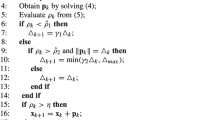Abstract
The family of gradient boosting algorithms has been recently extended with several interesting proposals (i.e. XGBoost, LightGBM and CatBoost) that focus on both speed and accuracy. XGBoost is a scalable ensemble technique that has demonstrated to be a reliable and efficient machine learning challenge solver. LightGBM is an accurate model focused on providing extremely fast training performance using selective sampling of high gradient instances. CatBoost modifies the computation of gradients to avoid the prediction shift in order to improve the accuracy of the model. This work proposes a practical analysis of how these novel variants of gradient boosting work in terms of training speed, generalization performance and hyper-parameter setup. In addition, a comprehensive comparison between XGBoost, LightGBM, CatBoost, random forests and gradient boosting has been performed using carefully tuned models as well as using their default settings. The results of this comparison indicate that CatBoost obtains the best results in generalization accuracy and AUC in the studied datasets although the differences are small. LightGBM is the fastest of all methods but not the most accurate. Finally, XGBoost places second both in accuracy and in training speed. Finally an extensive analysis of the effect of hyper-parameter tuning in XGBoost, LightGBM and CatBoost is carried out using two novel proposed tools.





Similar content being viewed by others
Notes
https://github.com/dmlc/xgboost (version 0.6).
https://github.com/microsoft/LightGBM/tree/master/python-package (version 2.3.0).
https://catboost.ai/docs/concepts/python-installation.html (version 0.16).
References
Babajide Mustapha I, Saeed F (2016) Bioactive molecule prediction using extreme gradient boosting. Molecules 21(8):983
Breiman L (2001) Random forests. Mach Learn 45(1):5–32
Breiman L, Friedman JH, Olshen RA, Stone CJ (1984) Classification and regression trees. Chapman & Hall, New York
Brown I, Mues C (2012) An experimental comparison of classification algorithms for imbalanced credit scoring data sets. Expert Syst Appl 39(3):3446–3453
Caruana R, Niculescu-Mizil A (2006) An empirical comparison of supervised learning algorithms. In: Proceedings of the 23rd international conference on machine learning, ICML’06. ACM Press, New York, pp 161–168
Chen T, Guestrin C (2016) Xgboost: a scalable tree boosting system. In: Proceedings of the 22nd ACM SIGKDD international conference on knowledge discovery and data mining, KDD’16. ACM, New York, pp 785–794
Demšar J (2006) Statistical comparisons of classifiers over multiple data sets. J Mach Learn Res 7:1–30
Dietterich TG (2000) An experimental comparison of three methods for constructing ensembles of decision trees: bagging, boosting, and randomization. Maxh Learn 40(2):139–157
Dwork C, Feldman V, Hardt M, Pitassi T, Reingold O, Roth A (2015) Generalization in adaptive data analysis and holdout reuse. Adv Neural Inf Process Syst 28:2350–2358
Fernández-Delgado M, Cernadas E, Barro S, Amorim D (2014) Do we need hundreds of classifiers to solve real world classification problems? J Mach Learn Res 15:3133–3181
Friedman JH (2001) Greedy function approximation: a gradient boosting machine. Ann Stat 29(5):1189–1232
Friedman JH (2002) Stochastic gradient boosting. Comput Stat Data Anal 38(4):367–378 Nonlinear Methods and Data Mining
Gumus M, Kiran MS (2017) Crude oil price forecasting using xgboost. In: 2017 International conference on computer science and engineering (UBMK), pp 1100–1103
Ke G, Meng Q, Finley T, Wang T, Chen W, Ma W, Ye Q, Liu TY (2017) Lightgbm: a highly efficient gradient boosting decision tree. In: Guyon I, Luxburg UV, Bengio S, Wallach H, Fergus R, Vishwanathan S, Garnett R (eds) Advances in neural information processing systems, vol 30, pp 3146–3154
Khramtsov V, Sergeyev A, Spiniello C, Tortora C, Napolitano N, Agnello A, Getman F, De Jong J, Kuijken K, Radovich M, Shan H, Shulga V (2019) KiDS-SQuaD: II machine learning selection of bright extragalactic objects to search for new gravitationally lensed quasars. Astron Astrophys 632:A56
Lichman M (2013) UCI machine learning repository. http://archive.ics.uci.edu/ml
Mirabal N, Charles E, Ferrara EC, Gonthier PL, Harding AK, Sánchez-Conde MA, Thompson DJ (2016) 3FGL demographics outside the galactic plane using supervised machine learning: pulsar and dark matter subhalo interpretations. Astrophys J 825(1):69
Nori V, Hane C, Crown W, Au R, Burke W, Sanghavi D, Bleicher P (2019) Machine learning models to predict onset of dementia: a label learning approach. Alzheimer’s Dementia Transl Res Clin Interven 5:918–925
Pedregosa F, Varoquaux G, Gramfort A, Michel V, Thirion B, Grisel O, Blondel M, Prettenhofer P, Weiss R, Dubourg V, Vanderplas J, Passos A, Cournapeau D, Brucher M, Perrot M, Duchesnay E (2011) Scikit-learn: machine learning in python. J Mach Learn Res 12:2825–2830
Prokhorenkova L, Gusev G, Vorobev A, Dorogush AV, Gulin A (2018) Catboost: unbiased boosting with categorical features. In: Bengio S, Wallach H, Larochelle H, Grauman K, Cesa-Bianchi N, Garnett R (eds) Advances in neural information processing systems, vol 31, pp 6638–6648
Rokach L (2016) Decision forest: twenty years of research. Inf Fusion 27:111–125
Torres-Barrán A, Alonso A, Dorronsoro JR (2017) Regression tree ensembles for wind energy and solar radiation prediction. Neurocomputing. https://doi.org/10.1016/j.neucom.2017.05.104
Valdivia A, Luzón MV, Cambria E, Herrera F (2018) Consensus vote models for detecting and filtering neutrality in sentiment analysis. Inf Fusion 44:126–135
Xia Y, Liu C, Li Y, Liu N (2017) A boosted decision tree approach using bayesian hyper-parameter optimization for credit scoring. Expert Syst Appl 78:225–241
Yoav Freund RES (1999) A short introduction to boosting. J Jpn Soc Artif Intell 14(5):771–780
Zhang C, Liu C, Zhang X, Almpanidis G (2017) An up-to-date comparison of state-of-the-art classification algorithms. Expert Syst Appl 82:128–150
Acknowledgement
The authors acknowledge financial support from the European Regional Development Fund and from the Spanish Ministry of Economy, Industry, and Competitiveness-State Research Agency, project TIN2016-76406-P (AEI/FEDER, UE) and project PID2019-106827GB-I00 / AEI / 10.13039/501100011033. The authors thank the Centro de Computación Científica (CCC) at Universidad Autónoma de Madrid (UAM) for the use of their facilities.
Author information
Authors and Affiliations
Corresponding author
Additional information
Publisher's Note
Springer Nature remains neutral with regard to jurisdictional claims in published maps and institutional affiliations.
Rights and permissions
About this article
Cite this article
Bentéjac, C., Csörgő, A. & Martínez-Muñoz, G. A comparative analysis of gradient boosting algorithms. Artif Intell Rev 54, 1937–1967 (2021). https://doi.org/10.1007/s10462-020-09896-5
Published:
Issue Date:
DOI: https://doi.org/10.1007/s10462-020-09896-5




